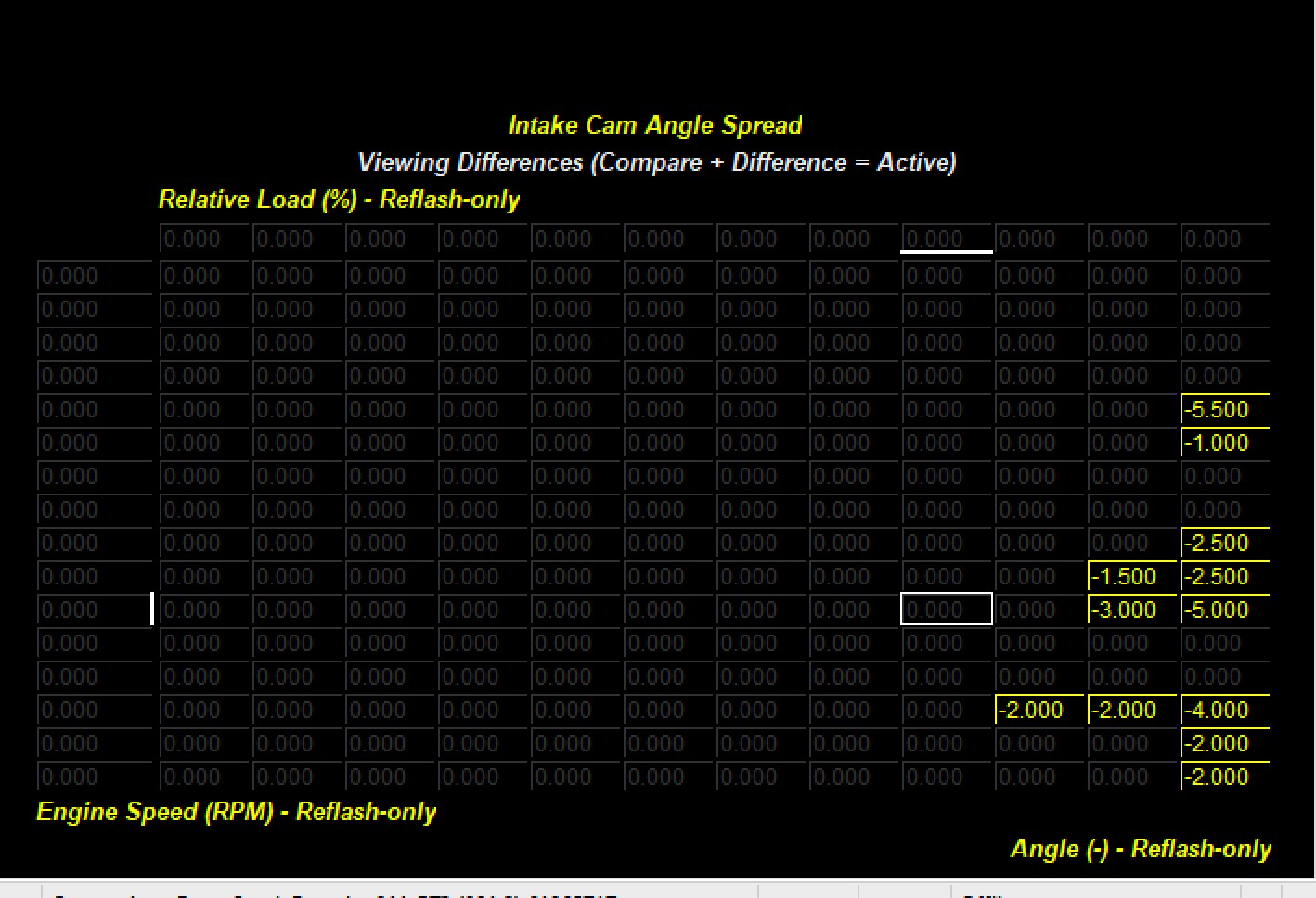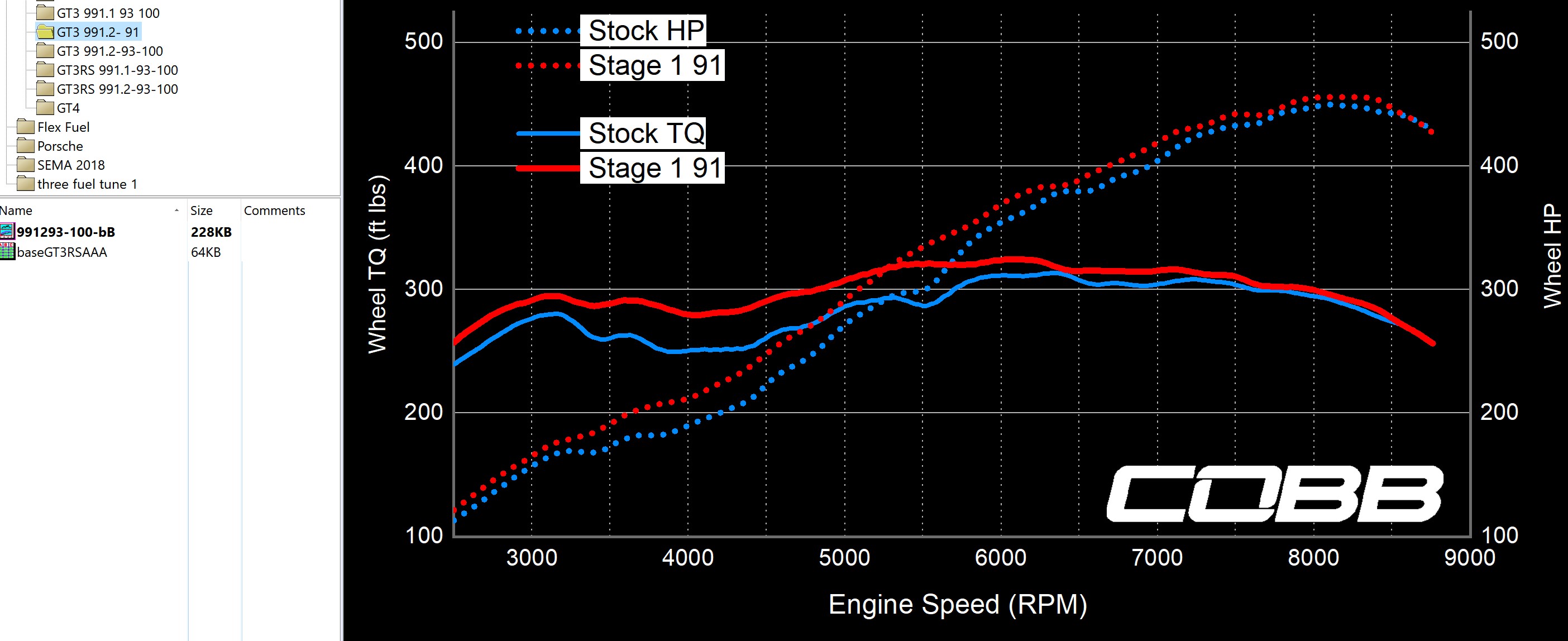Porsche 991.1 / 991.2 GT3, GT3RS Tuning Guide
- 2014-2016 991.1 Porsche GT3 WM
- 2016 991.1 Porsche GT3 RS WM
- 2018-2019 991.2 Porsche GT3 MT/PDK WM
- 2018-2019 991.2 Porsche GT3 RS MT/PDK WM
| Model | Displacement |
|---|---|
| 991.1 GT3 | 3.8 |
| 991.1 GT3 RS | 4.0 |
| 991.2 GT3 | 4.0 |
| 991.2 GT3 RS | 4.0 |
These are Porsche flagship track cars. They are designed for light weight and track style driving. They sacrifice lower RPM torque but produce flat torque and HP that continues to climb all the way to their rev limits of between 8400 and 9000 RPM.
Surprisingly these motors can be calibrated to produce more torque and HP. When first starting this project I was concerned that Porsche engineers had already extracted everything from these high rpm naturally aspirated motors. There are gains to be had in every model across the 991.1 and 991.2 GT3 car collection. The engine control systems refined by COBB Accessport include:
- Ignition Timing
- Intake Cam Timing
- Exhaust Cam timing
- Commanded Lambda
- Variable Intake Manifold configuration
- Variable exhaust configuration
- Requested torque
All of these vehicles calibrate in very a very similar manner and share the same ECU and calibration strategy. All vehicles refers to 991.1, and 991.2 GT3 and GT3-RS.
Ignition TIming
In most 991 generation cars, the Ignition timing is complex, with dozens of tables that reference cam position, valve lift, and other variables. (For example, the 991.2 911 turbo S has 128 timing tables). These GT cars are very different. In each case just one timing table is important Ignition Timing (Normal) 1. The X and Y axis of this table are RPM and Load. Our OTS calibrations utilise changes in this table but for the most part we've limited those changes to the sections commanding ignition timing at high load. This helps to preserve the quality of combustion and driveability at cruise, start up, and low load.
Important Monitors
Per cyl Ignition Timing (Final) (Degrees)
Ignition Timing (Optimal at Stoich) (Degrees)
Ignition Timing (Optimal) (Degrees)
Ignition Timing (Final) (Degrees)
Knock Ratard Average (Degrees)
Knock Retard (Cont. Knock) (Degrees)
Knock Retard (During Knock) (Degrees)
Knock Retard Cyl. 1 (Degrees)
Knock Retard Cyl. 2 (Degrees)
Knock Retard Cyl. 3 (Degrees)
Knock Retard Cyl. 4 (Degrees)
Knock Retard Cyl. 5 (Degrees)
Knock Retard Cyl. 6 (Degrees)
Load Actual (%)
RPM (RPM)
Requested Load (%)
Torque Control
Since these cars are making more torque it is sometimes important to inform the ECU of extra airflow and torque so that it does not relearn its output and ultimately reduce torque
Tuning Changes
991.1 GT3
93 octane baseline, 93 octane tuned, 100 octane. Most of these gains at higher load were created with a combination of lambda and ignition timing changes. Lower RPM changes were accomplished with exhaust valve and cam timing changes.
91 octane baseline compared to 91 octane tuned. These cars are designed for 93 octane and do not like being on 91 octane. The excessive knock experienced on 91 octane was reduced in the tune with changes as done in 93 and 100 octane but opposite ignition timing changes. 91 octane tuned makes slightly more than a stock car on 93
991.2 GT3
The 991.2 GT3 is a 4.0 liter car. The stock 991.2 GT3 is extremely impressive. This car makes as much power and more torque stock than does the 3.8 liter 991.1 GT3. The gains on this car above its 93 octane baseline are impressive. The low end torque gain was accomplished with cam timing, fuel control, and exhaust valve timing, Upper RPM increases were accomplished with lambda changes as well as ignition timing and further cam timing (intake and exhaust) timing changes. Large gains were accomplished on 93 octane. Smaller gains were accomplished on 100 octane.
Responded well to calibration refinement on 91 octane fuels. However, as with the 991.1, these tuning changes were not of large magnitude but simply allowed the car to run on 91 without knocking excessively. These marginal gains at higher RPM were in contrast to the large gains at lower RPM. Using similar approach as with 93 we preserved the huge torque gains at lower RPM. This makes the car a lot more drivable – even on 91.
991.1 GT3 RS
The 991.1 GT3 RS was the oddball of this group. Its an earlier car with the 991.1 series but was the first evolutionary move toward the 4.0 liter motor. With a smaller intake and exhaust cam, and a lower rev limit, this car made a little less in overall power gains, and made nearly the same with both 93 and 100.
991.2 GT3 RS
The 991.2 GT3 RS is supposed to make more power stock that the 991.2 GT3. Our test car actually made a little less everywhere. Furthermore, we were confused to see that the GTR3 and the GT3 RS calibrations are IDENTICAL. That said, the only way this car might make more power is through some additional intake charge via the large side scoops. As you might predict, the, the GT3 RS, used exactly the same calibration changes as our test 991.2 GT3. After all, they are the same engine and exactly the same ECU control.
Precautions
Fuel – The stock fuel system in the 991.2 Carrera is Direct Injection. Therefore the fuel is injected directly into the cylinder at very high fuel pressures to help atomize the fuel. There are limitations to these systems, so you will want to measure fuel pressure to see if you are having any issues with fuel delivery.
Related content
Copyright 2025 © COBB Tuning Products LLC. All Rights Reserved. | www.cobbtuning.com












